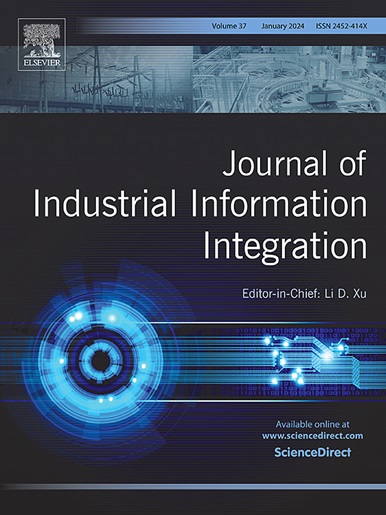SCL: A sustainable deep learning solution for edge computing ecosystem in smart manufacturing
IF 10.4
1区 计算机科学
Q1 COMPUTER SCIENCE, INTERDISCIPLINARY APPLICATIONS
引用次数: 0
Abstract
Edge computing empowered Deep Learning (DL) solutions have risen as the foremost facilitators of automation in a multitude of smart manufacturing applications. These models are implemented on edge devices with frozen learning capabilities to execute DL inference task(s). Nevertheless, the data they process is susceptible to intermittent alterations amidst the ever-changing landscape of dynamic smart manufacturing ecosystem. It sparks the demand for model maintenance solution(s) to address adaptability and dynamism issues to enhance the efficiency of smart manufacturing solutions. Moreover, additional issue(s), such as the non-availability of comprehensive data (or the availability of solely contemporary data), near-real-time execution of DL model maintenance task, etc., imposes daunting obstructions in devising an efficient DL model maintenance strategy. This work proposes a novel approach that encompasses the merits of Continual Learning (CL) and Split Learning (SL) driven by edge intelligence, amalgamating them into a hybrid solution aptly named Split-based Continual Learning (SCL). CL ensures the sustained performance of the DL model amidst constraints related to data availability. At the same time, SL empowers near-real-time execution at the edge to achieve improved efficiency. An extension of the SCL scheme, termed as Extended SCL (ESCL), is implemented to addresses the interaction soundness aspects among the mobile edge devices in a collaborative execution environment. Evaluation of a vision-based product-quality inspection use case in an emulated hardware test-bed setup signifies that the performance of SCL and ESCL schemes have the potential to meet the needs of smart manufacturing. SCL attains an appreciable reduction in the model maintenance cost in the range of 21 to 48 and 12 to 29 percent compared to the ECN-only and basic-SL schemes. The ESCL scheme further improved the performance by 18 to 34 and 20 to 36 percent respectively over the basic-SL and SCL.
SCL:面向智能制造边缘计算生态系统的可持续深度学习解决方案
边缘计算驱动的深度学习(DL)解决方案已成为众多智能制造应用中自动化的首要推动者。这些模型是在具有冷冻学习能力的边缘设备上实现的,用于执行深度学习推理任务。然而,在动态智能制造生态系统瞬息万变的环境中,它们处理的数据很容易受到间歇性变化的影响。这引发了对模型维护解决方案的需求,以解决适应性和动态性问题,提高智能制造解决方案的效率。此外,其他一些问题,如无法获得全面数据(或仅能获得当代数据)、近乎实时地执行 DL 模型维护任务等,都对设计高效的 DL 模型维护策略造成了巨大障碍。这项工作提出了一种新方法,它包含了边缘智能驱动的持续学习(CL)和拆分学习(SL)的优点,并将它们融合为一种混合解决方案,被恰当地命名为基于拆分的持续学习(SCL)。CL 可确保 DL 模型在与数据可用性相关的限制条件下保持持续性能。与此同时,SL 支持边缘近实时执行,以提高效率。对 SCL 方案进行了扩展,称为扩展 SCL(ESCL),以解决协作执行环境中移动边缘设备之间的交互健全性问题。在模拟硬件测试平台设置中对基于视觉的产品质量检测用例进行的评估表明,SCL 和 ESCL 方案的性能有可能满足智能制造的需求。与纯ECN方案和基本SL方案相比,SCL方案显著降低了模型维护成本,降幅分别为21%至48%和12%至29%。与基本 SL 和 SCL 相比,ESCL 方案的性能分别提高了 18% 至 34% 和 20% 至 36%。
本文章由计算机程序翻译,如有差异,请以英文原文为准。
求助全文
约1分钟内获得全文
求助全文
来源期刊

Journal of Industrial Information Integration
Decision Sciences-Information Systems and Management
CiteScore
22.30
自引率
13.40%
发文量
100
期刊介绍:
The Journal of Industrial Information Integration focuses on the industry's transition towards industrial integration and informatization, covering not only hardware and software but also information integration. It serves as a platform for promoting advances in industrial information integration, addressing challenges, issues, and solutions in an interdisciplinary forum for researchers, practitioners, and policy makers.
The Journal of Industrial Information Integration welcomes papers on foundational, technical, and practical aspects of industrial information integration, emphasizing the complex and cross-disciplinary topics that arise in industrial integration. Techniques from mathematical science, computer science, computer engineering, electrical and electronic engineering, manufacturing engineering, and engineering management are crucial in this context.
 求助内容:
求助内容: 应助结果提醒方式:
应助结果提醒方式:


